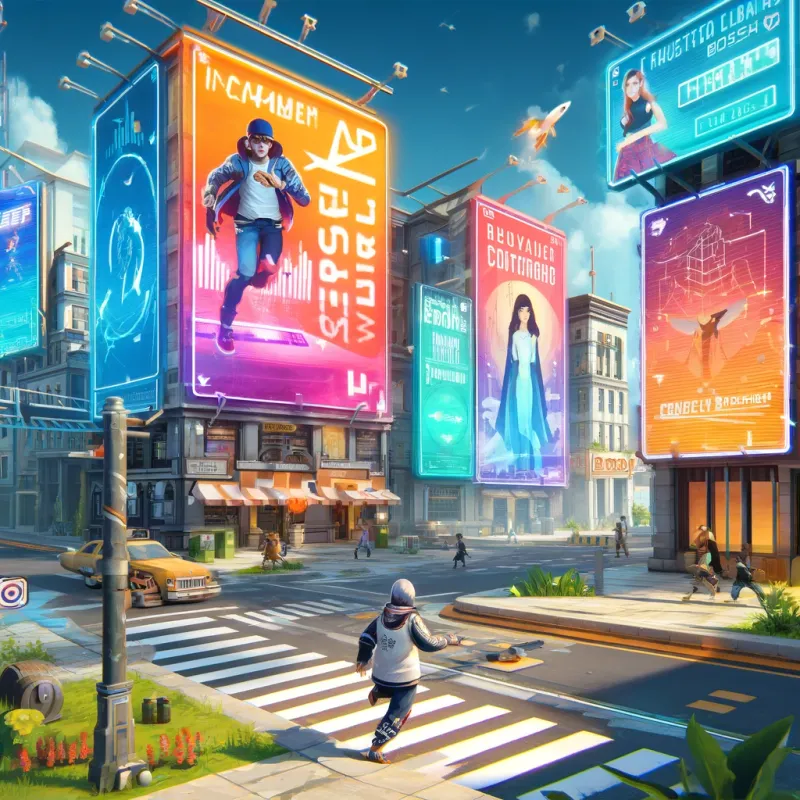What is In-Game Advertising for Mobile Games Studios?
Contents

Introduction
Game studios are constantly seeking innovative ways to monetize their games or sustain profitability, and that’s where in-game advertising comes into the picture. In-game advertising is a powerful revenue stream that has rapidly gained traction and has enabled game creators to offer immersive experiences while generating income. But what exactly is in-game advertising, and why has it become such an important component of the mobile gaming industry?
At its core, in-game advertising involves strategically integrating advertisements within the gameplay environment, while maintaining a seamless and non-intrusive experience for players and allowing developers to monetize their creations. As the demand for free-to-play games continues to soar, this monetization model has emerged as a win-win solution, allowing players to enjoy games without upfront costs while providing developers with a steady revenue stream.
However, in-game advertising is more than just a financial consideration, it requires careful planning, execution, and a deep understanding of user behavior. Today we’re getting into the intricacies of in-game advertising, its various formats, and benefits.
Different Types of In-Game Advertising
In-game advertising encompasses a diverse set of formats, each tailored to specific gameplay experiences and user preferences. The most prevalent ones are:
Static In-Game Advertising
- Billboards and Signage:
Similar to traditional outdoor advertising, static in-game ads are integrated into the game environment as billboards, posters, or signage. These ads are static, which means they’re non-interactive, remain constant throughout the gameplay and cannot be updated or changed very easily once implemented.
- Product Placements:
Similar to their counterparts in movies and television, product placements seamlessly weave branded items or logos into the game world, creating a natural and immersive advertising experience. In some games, players can interact with these placements as part of the game, providing a deeper level of brand engagement.
Dynamic In-Game Advertising
- Interstitial Ads:
These full-screen advertisements appear during natural breaks in gameplay, such as between levels or during the loading screen. They are designed to be minimally intrusive, fitting smoothly into the gaming experience to capture the player's attention. Once you are shown a video interstitial ad as a player, you can tap the skip button after a certain duration of watch time. Or, watch the entire ad and maybe even visit the destination page. Sometimes, these ads can be static too, but with the same skipping mechanism. - Native Banners:
These kinds of ads aim to be a natural part of the game by blending seamlessly into the game environment. Native banners mimic the visual style and aesthetics of the game, ensuring a cohesive and unobtrusive advertising experience. A native ad could be something as basic as panel ads in a football/soccer game or as intricate as a branded character skin. - Rewarded Video Ads:
This may be one of the most popular formats of in-game advertising. Rewarded video ads incentivize players to watch short videos in exchange for in-game rewards, such as virtual currency, power-ups, or extra lives. This model has been praised for enhancing player engagement while respecting their choice to view ads.
- Playable Ads:
These ads are very unique and offer an engaging experience. Playable ads are usually interstitial in nature and allow players to “test-drive” a game or app before deciding whether to download it. By doing so they effectively serve as an interactive advertisement and can lead to high conversion rates for the advertised games or apps. - Offerwalls:
Offerwalls present players with a catalog of activities or tasks they can complete in exchange for in-game rewards, currency or items. They’re mutually beneficial to game studios and advertisers by allowing players to earn rewards. The tasks can range from watching ads to completing surveys or downloading apps.
Benefits of In-Game Advertising
The appeal of in-game advertising extends far beyond revenue generation. When implemented thoughtfully, it can offer a multitude of benefits for both developers and players alike:
For Game Studios:
- Monetization Opportunities: In-game advertising provides a reliable and scalable revenue stream, enabling game studios to monetize their games without relying solely on in-app purchases or paid downloads.
- User Acquisition: By showcasing playable ads or promoting other games from their studio, developers can leverage cross-promotion opportunities to attract new players and expand their user base.
- Increased Engagement: Rewarded video ads and offerwalls incentivize players to remain engaged with the game, potentially leading to higher retention rates and longer gameplay sessions.
For Players:
- Free-to-Play Experiences: In-game advertising allows players to enjoy high-quality games without upfront costs, making gaming accessible to a broader audience.
- Value Exchange: Rewarded video ads and offerwalls provide players with a tangible value proposition, offering in-game rewards in exchange for their engagement with advertisements.
- Personalized Content: By leveraging user data and preferences, in-game ads can be tailored to deliver relevant and engaging content, enhancing the overall gaming experience.
Balancing User Experience and Revenue Generation
Even though in-game advertising offers an opportunity for monetization, it's important to strike a delicate balance between revenue generation and preserving a positive user experience. Excessive or intrusive ad placements can lead to player frustration, low NPS, and a negative impact on engagement and retention rates.
To maintain this balance, mobile game studios must adopt a user-centric approach, prioritizing the overall gameplay experience while strategically integrating non-disruptive ad formats. Continuous user feedback and A/B testing can help identify the optimal ad placements and frequencies, ensuring that players remain engaged and satisfied.
Conclusion: Embracing the Future of In-Game Advertising
Mastering in-game advertising requires balancing revenue generation and preserving a positive user experience. By seamlessly integrating ads, and incentivizing engagement, you can unlock the full potential of this lucrative monetization channel.
Looking ahead, the future of in-game advertising is brimming with exciting possibilities, driven by emerging technologies, evolving trends, and a growing demand for immersive and personalized advertising experiences. By staying ahead of the curve and embracing these advancements, game studios can future-proof their strategies and continue to captivate and engage their player base.
Have you mastered in-game advertising for your mobile games?

Comments
Your comment has been submitted successfully!